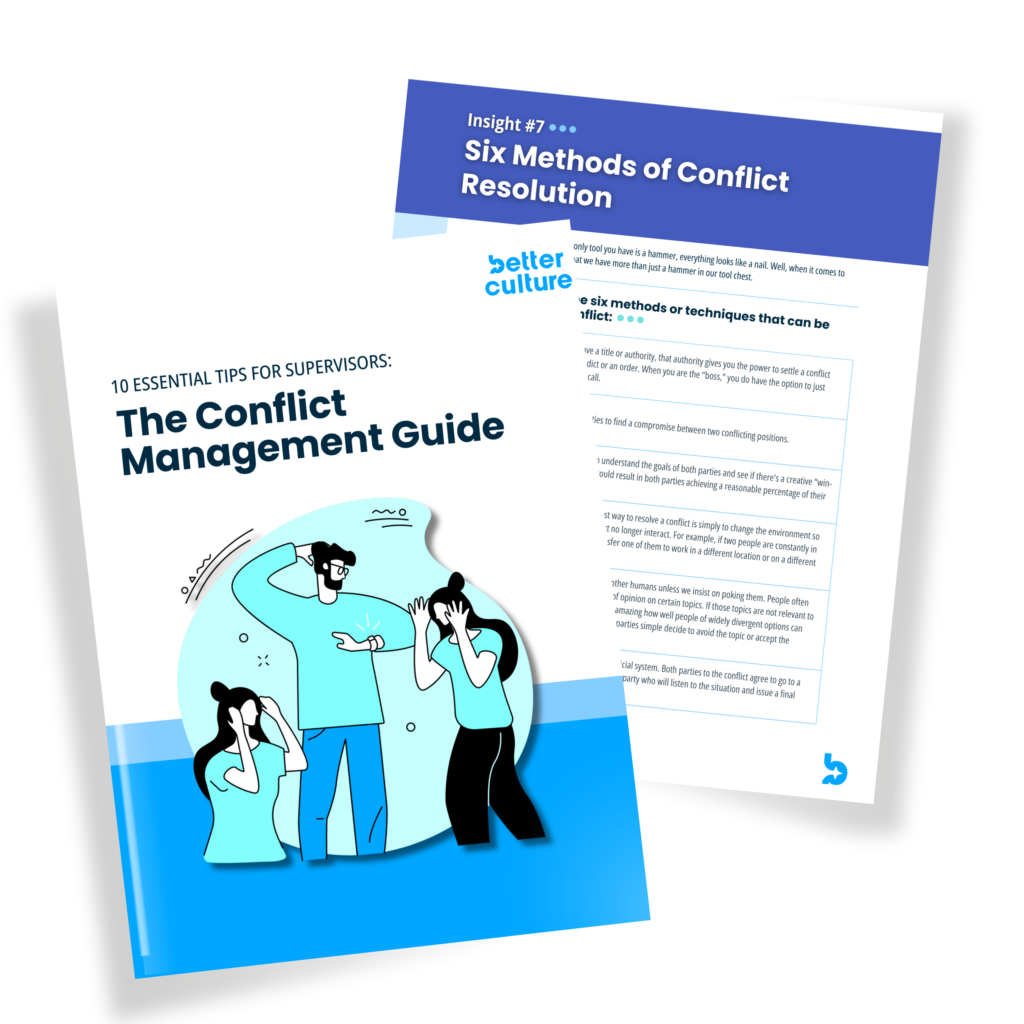If you were to attend any of the various leadership development programs offered by BetterCulture, it’s likely that you would hear your instructor use some variation of the following phrase in the program introduction:
“Outstanding leaders possess the mindsets and skillsets necessary to help their organization attract, build, motivate and retain an outstanding team.”
We start with this premise because the ability to attract and retain high-quality employees has become THE #1 challenge facing most businesses today.
Those italicized words (attract, build, motivate, and retain) are all about talent. Recruit talent. Develop talent. Inspire talent. And then keep that talent. Today we want to focus on the last of those key words: retain. If you are good enough to attract good employees, but not wise enough to retain them, you will be in a perpetual spin of tail chasing. Without addressing retention strategies, your excitement about the talent coming in the front door will be consistently undermined by concern for who is headed out the back.
Nothing sucks the wind out of a team and manager’s sails faster than learning that a valued team member has decided to leave the organization.
Unwanted turnover harms productivity and quality; it stresses the remaining (often now overworked) team members who are left to cover for the departed employee, and it burdens managers and HR teams who are tasked with identifying, onboarding, and getting new employees up to speed.
It is an obvious pain point for businesses. But what can employers do about it?
Before we can answer that question, let’s first examine why employees leave their jobs in the first place.
Why Do Employees Leave – and Stay?
You can search the web and find many research studies examining the factors that influence employees to leave their jobs, and that information can be interesting and maybe even helpful. For example, the Pew Research Center cited the following as the top three reasons employees left their jobs in 2021: low pay (63%), no opportunities for advancement (63%), and feeling disrespected at work (57%).
We think there is considerable insight to be gained by asking a slightly different question: why do employees stay?
Our BetterCulture survey data shows a clear and positive relationship between employees who report themselves as being likely to remain with the company and employees who report that the company has given them consistent and high-quality opportunities for personal and professional growth.
It turns out that one of the most potent tools at a company’s disposal to help retain top talent is the second of the four key terms – attract, build, motivate, and retain – we so often introduce at the start of our leadership trainings.
Employees are more likely to leave a job when they don’t feel they are learning, growing, or have opportunities for advancement.
This is not rocket science: one of the biggest reasons that good employees leave is that they don’t see a compelling reason to stay. They don’t see their company as being invested in their success. They don’t see growth prospects. They don’t see a future where compelling opportunities exist for them.
Just as a reminder for those of you who are familiar with our work at BetterCulture, Principle #3 from BetterCulture’s Seven Principles of Leadership© is: Leaders work hard to help staff be successful at work and in life. If you want to be successful at retaining your high-quality employees, you had better learn how to make this principle come to life.
A Tight Labor Market Makes Employee Development a Higher Priority
Before we turn to a few concrete ideas for what organizations can do to increase retention by providing employee development opportunities, let us share a brief comment about the reality facing many businesses today when it comes to hiring. When the labor market is highly competitive, the pool from which employers are able to hire new employees shrinks considerably.
As a result, if we rate new employees on a scale from 1 to 10 in terms of their readiness to be highly successful in our work setting, in an easy labor market we perhaps want to try and hire individuals who are at a 7 or above. In a tight labor market such as most employers are currently facing, however, it is often necessary for employers to hire lower quality candidates on overage – perhaps individuals who are in the range of 4 to 6. We can either bemoan this situation or we can recognize the opportunity (okay, the necessity) of becoming more effective at helping our employees grow; employers who want to win need to get really good at turning that 5 into a 7.
Beyond the obvious benefit that when you help an employee develop they become a larger asset to the organization, employers will also find that the employees they help to grow will be quite loyal to both their company and the supervisor who invested in them.
The implication for retention is obvious. A powerful way to improve your retention is to deepen and enrich your commitment to Principle #3 above.
Four Employee Development Approaches that Boost Retention
Here are four ideas that employers can use to increase employee retention by focusing on employee growth and development:
1: Invest in high quality training opportunities for your staff.
This means bringing in top-notch individuals to talk with your staff about a wide variety of topics that can help improve their performance at work and/or empower their success in life.
If you can create a culture of constant curiosity and learning, and permeate that culture to individuals in every role and at every level of the organization, employees will be much less likely to feel “stuck” or immobile in their current role.
Helpful Aside: When you do bring in such outside trainers and speakers, make sure they understand that they have two objectives while interacting with your teams. The first is to present useful and helpful information and insights. The second is to make sure your team members value and appreciate that they work for a company who makes this kind of unusual commitment in their development.
Any outside presenter has the opportunity to help you re-recruit your employees by acknowledging and praising the level of commitment your company is making to its employees. It’s an opportunity that your organization should insist outside presenters not fumble away.
2: Offer effective mentoring opportunities for select employees.
Most mentoring programs within companies fail because of poor planning or slipshod implementation. It would take a longer article (or a really outdated video like this one we just found by one of our BetterCulture co-founders Blake Hoogeveen – you’re welcome Blake!) to explain all of the elements that comprise a great mentoring program, but BetterCulture is available to consult with you if you would like to learn how to do this well.
One other quick comment on the topic of mentoring: supervisors can help their employees grow by linking them to people not only inside the company, but also to individuals outside the company. These need not be long-term relationships – employees can often accelerate their personal growth by just one interaction with the right person at the right time. We like to call these one-time encounters (often over a cup of well-brewed coffee) micro-mentor sessions. If you’d like to know more about establishing a mentoring program that works or encouraging more micro-mentoring among your team, let us know.
3: Career ladders (the BetterCulture way).
This next suggestion is one only a select minority of companies will take the time to understand and implement. We’ve shared it with hundreds (maybe thousands) of organizations, but there are very few that we are aware of to have successfully implemented this strategy. Typically whoever we are speaking with nods their head and says they agree it could be a powerful tool. They then promptly go back to doing things the way they have always done them (and they keep getting the lackluster results they’ve always gotten). Is this frustrating to us? Why, yes it is!
Employees want to have an opportunity for advancement within the company. Obviously, it’s not always possible to continue to provide promotion after promotion to every good employee who desires a sense of forward progression in their career.
One step that will help in this regard is to create a career ladder program within given job categories. Understand that this is not a new job class. For example, advancing on the career ladder does not require a new job description. Rather, employees may earn a special designation within a given job classification.
A few things to consider in getting this right:
- We recommend that employees not be able to apply for such advancement. Opportunities to participate in a career ladder advancement program should be by invitation only (in other words, appropriately timed and deserved).
- Employees should be required to complete additional training and experiences to earn the designation.
- Additional notoriety and exposure should be provided to these employees. Let others know that they are valued for their exceptional efforts, characteristics, and potential.
- A wage increase is usually associated with this achievement, but often it need not be excessively large.
Again, our unique approach to career ladders is a specialty of BetterCulture’s. Our approach is different (and better). If you’d like help exploring this type of a career ladder program in your organization, drop us a line.
4: As stated in Principle #3 above, employees want to work for an organization that makes an investment not only in their success at work, but also in life.
Although admittedly self-promotional, we encourage you to take a strong look at BetterCulture’s 20 Tenets program. It is one of the most impactful ways any organization can show their employees a genuine interest in helping them become more successful – both at work and in life.
Bottom line: of course organizations need to continue to work at attracting top talent. But you have that talent inside your circle, it’s time to start getting creative and diligent at providing opportunities for both professional and personal growth.
Such commitments are naturally reciprocal. When you invest in your employees’ success, they will be all the more likely to return the favor.



